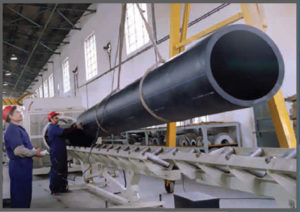HDPE Pipes
Polyethylene Pipes the Champion
According to the Research Studies by Freedonia Group the demand for PE all around the world is forecasted to increase over 5% per year to about 54 million metric tons by the year 2003. Its estimated that it would remain the largest consumed thermoplastic resin in the world defeating polypropylene and polyvinyl chloride PVC by almost double the amounts consumed of both.
Benefits Of HDPE Pipes:
HDPE Pipes are today the right choice for Water and Gas supply over the conventional piping systems. Following are some benefits of using pipes made from polyethylene:
- Corrosion, chemical, abrasion, weathering resistance all contribute to a maintenance free long life span.
- HDPE Pipes find applications in a board range of applications among various industries for above / underground, surface / sub surface or even floating applications.
- The greater flexibility and lightweight reduces installation costs.
- These pipes can carry various kinds of wastes; they can transport portable water, chemicals, compressed gases (like fuel gases) etc.

Applications Of HDPE Pipes:
API HDPE Pipes are specified with confidence in the following area:
- ENGINEERING (Sewer effluent control and water purification)
- QUARRYING (Conveyance of water and air in under ground operations)
- FARMING (Irrigation system and water supply schemes)
- CONSTRUCTION (Connections and cold water reticulation system)
- INDUSTRIAL (Conveyance of chemicals and water in most industrial plants
HDPE Fittings:
We have made all necessary arrangement for the supply of HDPE pipe fittings necessary for the installation of the pipes. Completes range of fitting from Bends to Tees is available. All efforts to ensure the quality control of the fittings are made and not only the pipe but also the fittings area rigorously tested.
Prominent Features of PE Pipes:
PE Pipes save both Time and Money High Impact Strength: PE pipes have great impact resistance as compared to other thermoplastics even at low temperatures. This inherent feature of PE pipes ensures resistance to external loads, pressures or vibrations in earth quake prone areas. Thus pipes are inherently tough and can withstand great amounts of forceful damages from surroundings.

HDPE PIPE’s Feature and Benefits
- Good impact strength: Little handling and installation damag
- Excellent corrosion resistance: Long and efficient service life
- Good Chemical resistance: Wide variety of application
- Flexibility: Easy Installation
- Long length available: fewer joints
- Good impact strength: Little handling and installation damag
- Good abrasion resistance: Can be used to pup slurries
- Good UV resistance: Can be use in exposed locations
- Low friction losses: Lower pumping costs
- Several jointing methods: Wide variety of application
Expansion and Contraction
All plastics have high a co-efficient of expansion and contrcation, several times those of the metals. This must be allowe for in any installation by the use of expansion joints, expansion loops etc

Comparison of HDPE and PVC Pipe

Pressure Ranges
The operating pressure of the pipes manufactured by API, has is within the ranges of 6, 8, 10, 12.5 and 16 bar. PN is the nominal pressure rating in bars, which indicates the maximum pressure in bars the pipe can support at 20°C.
Pipe Length Ranges
API produces straight pipes in lengths of 6m up till 12m for all outside diameters. Coiled pipes are also easily manufactured for diameter up to 110mm for the length of 100. Meters. There are a number of flow formulae in common use which have either a theoretical or empirical background. However, only the Hazen-Williams is considered in this section.
